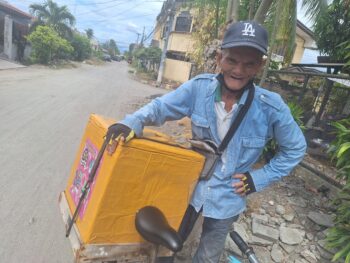![[A SOJOURNER’S VIEW] Neil Fraser: Mindanawon Visual Artist Par Excellence 1 27mindaviews sojourners](https://mindanews.com/wp-content/uploads/2020/09/27mindaviews_sojourners-630x354.jpg)
CEBU CITY (MindaNews / 23 April) — In 1965, the English songwriter-singer Jonathan King recorded a song entitled Everyone’s Gone To The Moon. Part of the lyrics of the song goes this way:
Streets full of people, all alone, Roads full of houses, never home
Church full of singing, out of tune, Everyone’s gone to the moon
Eyes full of sorrow, never wet, Hands full of money, all in debt
Sun coming out in the middle of June, Everyone’s gone to the moon.
I was then in second year college at the Ateneo de Davao, still grappling with growing up pains and dealing with being away from home and childhood friends. So when I heard the song over the radio, it resonated very deeply and somehow helped assuage the adolescent blues!
Lately, the haunting song has been in my mind and thanks to Google, it can now easily be retrieved. With the recent sad news of old and new friends dying and/or getting sick, one cannot help but feel blue. As I listen to the song now, memories flood my mind. Just as we buried a most cherished confrere in Cebu – Fr. Alfonso “Fons” Suico, Jr. CSsR on Saturday, April 22, news reached me that out there in Australia, a long-time friend – Neil Fraser – died of cancer.
Meanwhile, among my circle of family and friends, there’s been a flood of news regarding loved ones who are at various stages of health crisis. I spent an afternoon recently with two former co-workers: one very sick of diabetes and another recently hospitalized due to a vertigo attack. I myself have had to deal with my own health challenge, although lately I’ve been on the road to recovery.
Another long-time friend – who like Neil Fraser used to work as a Columban missionary in Mindanao, Vin Hindmarsh – wrote to me regarding the circumstances of Neil’s passing. “(It is) just sad about the circumstances. In the end, the end came quickly for Neil. The doctor said his cancer was very advanced and aggressive, had started in the kidney, then had spread to his bladder. Any surgery was not advised, given his age so Neil prepared for the inevitable. Yes, he did go back to RP (Republic of the Philippines) last October intending to stay but the RP doctor gave such a dramatic diagnosis that his family decided it best he return to get a second opinion in Australia. As it turned out, it was the same diagnosis. It was a shock to hear, however, that he had only five weeks to live and pain management was the only course open to him. I get emotional just thinking about it, but how much more for him. He was surrounded by family which was important, Coring and his two sons with their families.”
For those of us active in the Mindanawon civil society organizations (especially with faith-based institutions connected to the Mindanao-Sulu Pastoral Conference) of the 1970s-1980s, Neil cut a most imposing figure, despite being short for a Caucasian. An Australian missionary who came to western Mindanao, learned Cebuano (and spoke it fluently), with a face that manifested a deep sense of compassion, Neil easily made friends with everyone.
He was one of the young, renegade Columbans – Irish, Australians, New Zealanders, British – who arrived in Mindanao after the war to administer the parishes across Western Mindanao from the Archdiocese of Cagayan de Oro to the Diocese of Pagadian (with Iligan and Ozamiz in between). At the height of the Columban presence in Mindanao, there were easily more than fifty of them. Neil was one of the bright-eyed young priests who arrived in Mindanao just as the 1960s gave way to the 1970s when the country’s tumultuous years were shaping up.
He had a keen eye for observing the intricacies of people’s lives and the beauty of nature while nurturing his sense of adventure. Which easily were the reasons why he turned to photography, developing black-and-white and colored photos. His black-and-white photos – similar to those taken by the late Bishop “Tatay Bido” Tudtud, whom he befriended while based in Marawi, were some of the best photos we saw in that era.
Documentation work – needing a lot of media support – was a crying need as martial law worsened and it became more important to inform the public about the atrocities of the Marcos regime given the media censorship. Alternative media evolved with the use of micro-media involving mimeographing machines, blackboards, theatre, photography and sound-slide productions. Across Mindanao there arose the setting up of research and documentation centers including AFRIM in Davao City, FarmDev in Butuan City and others in the cities of Cagayan de Oro and Iligan. Neil saw his niche in this field and explored as best as he could through the setting up of a Media Center based in Ozamiz City.
Learning of his death, Arnold Vandenbroeck – who helped set up FarmDev – wrote to his friends: “Neil’s inspiring contribution to awareness raising in and about Mindanao through group media in the 1970s and 1980s was simply outstanding.” Many of us across this network of human rights advocacy and, later, with ecological engagements, remember Neil fondly and are grateful for the opportunity of knowing and working with him.
Priesthood must have not suited what he wanted to do with his life. Falling in love with a local maiden – his teacher at the language school, Coring – he decided he would get married and raise a family. But instead of returning to Australia, he remained in Mindanao, first working with the Dansalan Center in Marawi City. Later, he returned to Ozamiz to expand the Media Center at the time when Mindanao needed good and committed talented artists like him. He then pioneered in learning the techniques of using a video camera when it came out in the market and produce video films.
He went full blast into documentation work with his photography and video engagements. With Fr. Sean McDonagh SSC – the Columban anthropologist now a world-renowned creation theologian – who was then based among the Tboli in Lake Sebu, they produced what would be some of the most important documentaries ever filmed regarding the beauty of Lake Sebu and the Tbolis. But at the same time also revealing the fragility of this fabled place’s eco-system.
From their combined efforts, were produced these two classic video productions –
The Vanishing Earth and Earth Music. (I wonder if the Columbans will post these videos on YouTube so more can watch what would be one of the first documentaries of IPs in Mindanao in the contemporary period). With these films, one can intuit into what were Neil’s dreams for peace in Mindanao, among its peoples and the whole of creation! Neil and his staff also ventured into producing docu-dramas tapping into Mindanao’s performing talents.
Cebuano films used to be shown across the Visayas and Mindanao in the 1950s to 1960s, but disappeared from the scene when Tagalog films dominated the market. Neil saw the potential of resurrecting films in Cebuano contextualized within the Mindanawon realities but in video form. These were mostly one-hour productions and most of the filming were done around Western Mindanao and editing was done in his Media Center. He managed to produce a few of these films, packaged as DVDs and sold in the market. Unfortunately, the market was too small to keep the enterprise afloat. Eventually he did a lot of documentation work.
Eventually as the years passed and family needs caught up with him, he and Coring left for Australia where he stayed in the last few decades. Still, he yearned to return to Ozamiz and had made plans to do so. But it was not meant to be. He died in Australia.
Our memories of Neil will always be of this kind-hearted, talented artist, committed ecologist with a zest for life! It is hard to imagine him no longer alive, and yet we are comforted with the thought that out there – in the beyond – his dreams live forever! And perhaps we can still echo the song with these lyrics:
Friends from the years gone, are journeying towards our common home
We miss their presence when they’re gone, As everyone’s gone to the moon.
(MindaViews is the opinion section of MindaNews. Redemptorist Brother Karl Gaspar is Mindanao’s most prolific book author. Gaspar is also a Datu Bago 2018 awardee, the highest honor the Davao City government bestows on its constituents. He is presently based in Cebu City).







